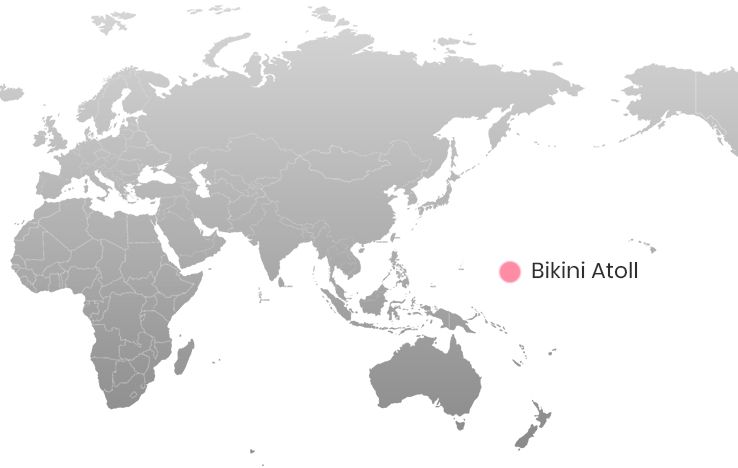Bikini Atoll could be the perfect place for a heavenly relaxing vacation if not the nuclear bombing that took place more than 70 years ago on these remote atoll islands. In fact, it was once, before it was blown up into the air by 23 highly-destructive nuclear bombs. In this blog post, we address the most asked questions about Bikini Atoll's history and its state in the present day. Read on to find out the story of this destructed paradise that might give you goose bumps and nausea.
Bikini Atoll Ironic History

Between 1946 and 1958, which means right after World War II has been taken to an end, the US has aimed its most potent weapon to a location that was distant enough to be tested on. In the middle of the Pacific ocean can be found islands that surprise with their beauty, but that wasn’t the reason for the US army to head to the location. The remoteness was the only condition, but surprisingly, the choice fell on the atoll that was inhabited. As a result, 167 inhabitants had to be removed from the paradisiac islands to the nearest Rongerik Atoll. Then they were relocated to Kwajalein Atoll, and in the end to Kili Island, where the major part of the Bikinians can be found today.
The rest was history. In the summer of 1946, two test bombings had been scheduled to be performed on the atoll islands - a newly acquired test site for the US. The goal of this extremely deadly plan was to demonstrate the freshly obtained nuclear power. What would they do if they knew about the aftermath that even today is being recalled? Either way, the destruction was done, so we only had to learn the lesson and move on. The irony of the terrible history of Bikini Atoll is that significant research is done nowadays due to it. These might help humankind discover how to live longer, as Stanford biology professor Stephen Palumbi stated in his Big Pacific documentary.
Bikini Atoll nuclear tests had a huge influence not only on the landscape but also on the life on it as well. In fact, the impact was so much more devastating than it was supposed to be. In 1954, the first, but the most powerful weapon for that time, the hydrogen bomb was detonated. The explosion was 2.5 times larger than it was expected. Radioactive ash was found on more than 7,000 square miles away from the site. The rest of the world wasn’t beyond the reach of the blast, as well.
After nuclear tests took place on the atoll islands, including Bikini Atoll, the entire world was contaminated with Carbon 14. That is a radioactive isotope that, in nature, is created by cosmic rays after they interact with nitrogen. As the air got struck by C-14, concentrations twice as much of it were discovered in every human on the planet. Though the radioactive fallout debris had been collected and placed in a crater under a dome, named the Runit dome, the impact was so vast that it is recalled to this day.
As a conclusion, life on atoll islands has been drastically changed - the water got contaminated with strontium-90 and became radioactive. As a result, the plants and eventually the fauna became radioactive too. In an attempt to regain the trust of nature, hundreds of palms were planted on the Bikini Atoll. That ultimately created an image that strikes with creepiness due to the steadiness and the highly planned arrangement of the plantation. In addition to that, the tranquil islands shout about the oddity of the location because of the scattered plane and ship parts that were previously exploded. If you got to visit the place, you’d be able to see how beauty can be destructive.
Bikini Atoll Tourism and Facts

As early said, we want to address the top questions about Bikini Atoll, after which you’ll be able to tell if you can travel to this lost paradise or not. So, where is Bikini Atoll after all? Located in the middle of the Pacific Ocean, the reef islands are part of the Marshall Islands, thus are considered Micronesian Islands. It also sits half-way between Hawaii and Australia.
If you asked yourself whether or not the place is safe, then we’d answer that it is safe until you carry with you enough water and food to live in it. As mentioned before, soil, underground water, fish, and plants (especially coconuts) are still radioactive. Thus, you’d have to bring food and water from outside the islands. On the other hand, the air is perfectly fine, and no leftover radiation can be found on the atoll.
For divers, there is good news as diving in Bikini Atoll lagoon is highly practiced. Though it implies a 27-hour boat ride, including several hops between islands, the treasures that lay beneath the water surface are worth it. The imposing armada of the sunken ships, and especially the USS Saratoga, is an unbelievable finding for scuba divers.
Another question that you may ask is whether or not Bikini Atoll is habitable. Though in the ‘70s, bikinians were relocated back to their homeland, 10 years later, they were removed from the atoll islands altogether. The reason behind was the high levels of cesium that were found in the soil, plants, underground water, and animals of the islands that impacted on the inhabitants’ health. To this day, the reef islands are still inhabitable. And yes, there are no weird creatures on the Bikini Atoll.
The Future of Bikini Atoll
The damage that was done to not only Bikini Atoll, but also on the nearest atoll islands of the Pacific Ocean, marked the beginning of the nuclear age. Though the gained strength impacted the lives of thousands of people, on the health of millions, and on nature itself, life goes on, and we only have to learn of it.
Nuclear bombings are happening to this day, and we can’t stop the progress of this dangerous industry. The destructions caused by nuclear bombings are the last thing to think about. The nuclear waste is what matters, as it can impact nature wholly. Remember the Runit dome located on Enewetak Atoll? It was reported that it has been cracking lately. That means that we are in danger, and the radioactive debris that was collected after nuclear weapons had been tested on the coral atolls of the Pacific, could spread across the globe in case the ceiling of the dome collapses. Hopefully, that will never happen.
The radiation of Bikini Atoll will be entirely gone after several decades or even hundreds of years. Nature and the entire humankind are in danger, so we only have to hope that nuclear tests are going to be stopped, and nobody will be suffering.
Last Updated on November 13, 2019.

